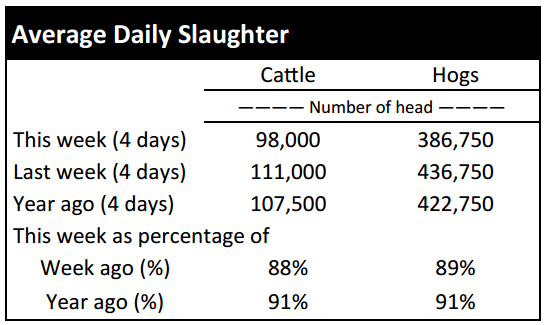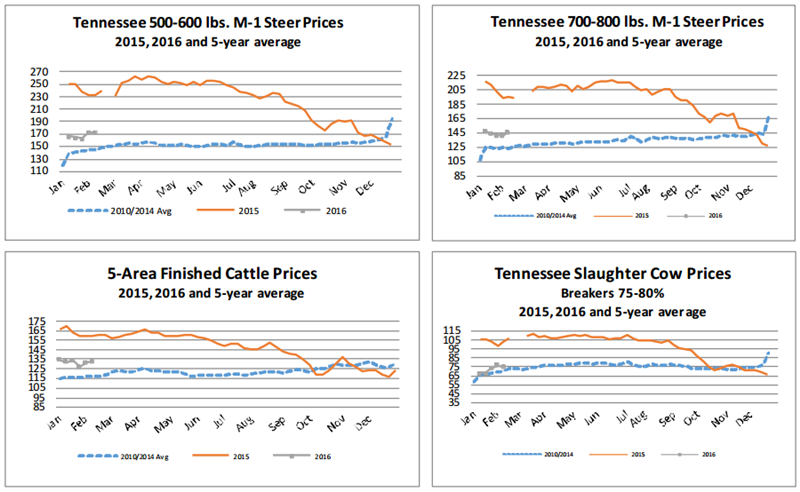Market Highlights: Tennessee's Cow Herd is Expanding
By: Andrew P. Griffith, University of Tennessee
FED CATTLE: Fed cattle trade was not well established at press. Live cattle bids ranged from $136 to $138 with asking prices $2 to $4 higher. The 5-area weighted average prices thru Thursday were $132.20 live, up $1.20 from last week and $210.00 dressed, up $0.86 from a week ago. A year ago prices were $158.73 live and $252.00 dressed.
Cattle were slow to move this week as feedlot managers were holding out for stronger prices. Recent success in the cash market has feedlot managers bullish on the market. Alternatively, some managers are slow to market cattle that have been storm stressed as a few extra days could do them a great deal of good in recovery. The winter storms are definitely resulting in reduced finished weights and could continue to wreak havoc on the feeding industry from a feed efficiency standpoint.
Packers on the other hand are reluctant to follow the cattle feeders’ bullish tendency as beef is a slow mover in late winter months. The tug-of-war will continue and who wins may depend on the consumer or mother nature.
BEEF CUTOUT: At midday Friday, the Choice cutout was $222.50 down $0.53 from Thursday and up $3.65 from last Friday. The Select cutout was $218.45 down $0.03 from Thursday and up $1.12 from last Friday. The Choice Select spread was $4.05 compared to $1.52 a week ago.
The winter weather slowed beef movement a couple of weeks ago, but the retail sector jumped back in the market to service short-term needs and to restock shelves. February tends to be a weak demand month for beef as lower valued cuts lead the way and as other meats tend to fare a little better. Maybe the most disappointing side of beef in the current market is 50 percent lean trimmings.
They were fairly strong throughout 2014 and started 2015 strong but faltered late in the year. Fifty percent lean trimmings are currently trading more than $30 per hundredweight lower than the five-year average.
Alternatively chuck prices continue to hold steady as they usually do. They are not doing anything to spur beef prices higher, but they are also not doing anything to pressure prices lower. Beef prices may be supported through the rest of this winter if rough winter weather continues to batter cattle feeding country which results in reduced feed efficiency, lower dressed weights and higher mortality rates and thus lower beef production.
OUTLOOK: The past two weeks have been about the most steady trade feeder cattle futures have witnessed in more than a year. Most contract months have had close prices within a $4 range the past two weeks. This is a substantial change from previous months’ trade where the range of close prices over any two week period has commonly been $15 to $20. Another noteworthy aspect of feeder cattle futures is that the contract months from March through September only have a $2 spread which would not be indicative of the seasonal trend.
Additionally, the January 2017 contract is trading at more than a $10 discount to the nearby contract. However, part of this decline is due to the contract weight range for feeder cattle contracts increasing from 650 to 849 pounds to 700 to 899 pounds. The increase in the average weight has shifted futures for the November 2016 contract and beyond down $4 to $5 which is part of the decline in the January 2017 contract.
The question to be answered is, “What does all of this mean?” First of all, seasonal price trends are expected to reestablish themselves in the market. There have already been some small signs of price seasonality returning in the cash market but slow to appear in the futures market.
To some extent, the lack of a spread over the next seven months would indicate that traders are unsure of the true value of feeder cattle or where prices should move compared to today. This is little reason for concern as the local cash markets continue to do business as expected.
Steer and heifer prices were steady to a few dollars stronger this week compared to a week ago. The expectation is for the price of lightweight calves ready for grass will continue to inch up through February and then really gain steam in March.
Sellers should be keeping a close eye on the calf markets during this time to capitalize on the price improvements. Alternatively, cattle buyers may want to secure inventory a little earlier than normal if cattle are available. It could be the difference of $50 to $100 per head purchase price.
Cattle inventory in Tennessee increased 6.4 percent to 1.83 million head while the beef cow herd increased 2.6% to 896,000 head. Heifers held for beef cow replacement were up 14.3 percent compared to a year ago and totaled 160,000.
ASK ANDREW, TN THINK TANK: A question was asked in Cannon County this week concerning the repeal of mandatory country of origin labeling (MCOOL) and how that might impact the domestic beef market. There is no way to do the topic justice in this short section but the high points can be hit. The repeal of MCOOL will allow for cattle to cross the Canadian and Mexican borders a little more easily. The largest complaint by packers was the additional cost associated with segregating cattle and individual cuts of meat. It also has huge implications for feedlots as many cattle are fed in Canada and harvested in the United States. The repeal of the law may result in more cattle being finished in Canada instead of being shipped to the United States as feeder cattle and finished.
Whether a proponent or opponent of the law, it will impact markets as the industry adjusts.
Please send questions and comments to agriff14@utk.edu or send a letter to Andrew P. Griffith, University of Tennessee, 314B Morgan Hall, 2621 Morgan Circle, Knoxville, TN 37996.
FRIDAY’S FUTURES MARKET CLOSING PRICES: Friday’s closing prices were as follows: Live/fed cattle –February $135.93 -1.15; April $134.08 -1.58; June $123.65 -1.15; Feeder cattle - March $153.28 -3.25; April $153.00 -3.03; May $152.50 -2.90; August $153.05 -3.28; March corn closed at $3.66 down $0.03 from Thursday.











